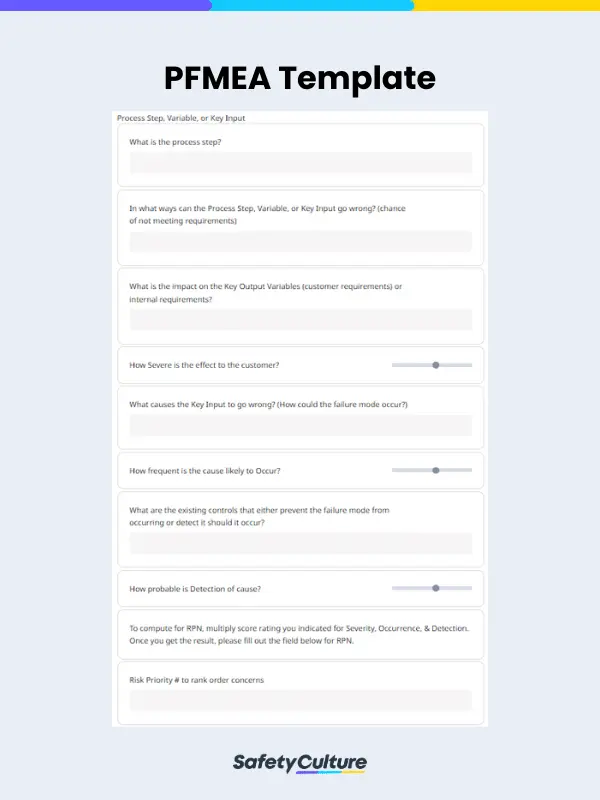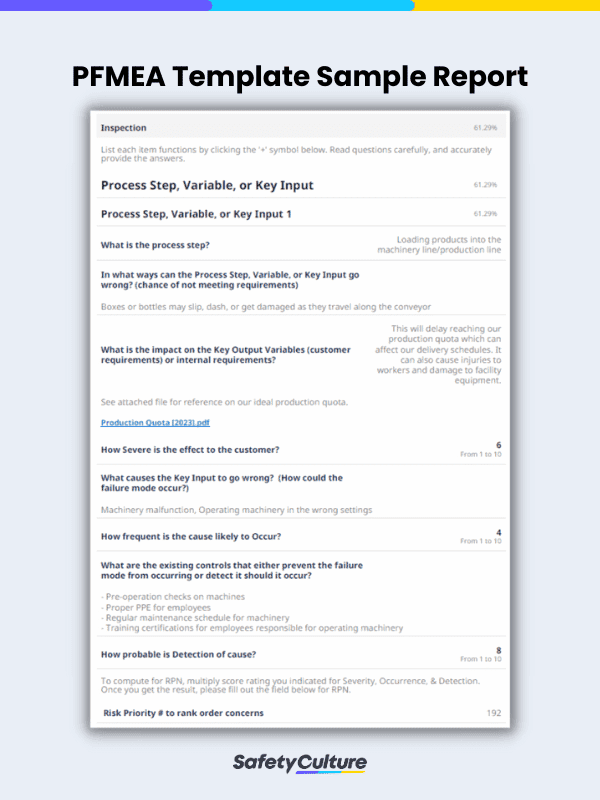What is a PFMEA Template?
A Process Failure Modes and Effects Analysis (PFMEA) template is a tool used by organizations when conducting a PFMEA, helping them systematically identify potential failure modes, their causes, and their effects on processes, products, or services. It’s valuable in taking preventive or corrective actions, mitigating risks, and continuously improving processes to ensure quality, efficiency, and customer satisfaction.
Why Use a Template When Conducting PFMEA
Using a PFMEA template provides a standardized approach for conducting the analysis, ensuring that all relevant information is captured consistently. It also helps facilitate communication and collaboration among cross-functional team members involved in the process. Lastly, the template, once completed, serves as a reference document for tracking the progress of mitigation efforts and updating the analysis over time.
Other key benefits of using a PFMEA template that organizations in various industries can achieve include the following:
- Proactively identify and prioritize risks – This proactive approach allows organizations to make potential risks known and rated before they impact product quality or customer satisfaction.
- Mitigate risks – A PFMEA template helps organizations brainstorm potential corrective actions, evaluate their effectiveness, and implement them in a timely manner to reduce the likelihood of failures, defects, or customer complaints.
- Improve processes – It helps organizations review and update their PFMEAs regularly, incorporate lessons learned from previous failures, and implement process improvements to prevent similar incidents in the future. This continuous improvement approach helps organizations to optimize processes, reduce risks, and enhance overall business performance.
What to Include in One
A PFMEA template must have several key components to ensure a comprehensive and systematic approach to identifying, analyzing, and mitigating potential failure modes and their effects. Here are some essential elements, sections, and fields that should be included in it:
- Process Steps – The PFMEA template should include a detailed list of all the steps involved in the specific process being analyzed. This helps in identifying potential failure modes at each step of the process.
- Potential Failure Modes – For each process step, the PFMEA template should include a list of potential failure modes, which are the ways in which the process could fail to meet its intended objectives. These failure modes should be identified based on experience, historical data, and expert knowledge.
- Causes and Effects – The PFMEA template should include a column to capture the causes of each potential failure mode and the effects or consequences that may result from the failure.
- Severity Rating – This section is intended for assigning a severity rating for each potential failure mode, measuring its seriousness on a scale of 1 to 10 (with higher numbers indicating more severe consequences).
- Occurrence Rating – This is the section dedicated to rating each potential failure mode’s likelihood or frequency of occurring. It also uses a scale of 1 to 10 (with higher numbers indicating higher occurrence rates).
- Detection Rating – To measure each potential failure mode’s detection capability before it reaches the customer or causes harm, this section lets you assign a detection rating on a scale of 1 to 10 (with higher numbers indicating higher detection capability).
- RPN – The PFMEA template should also include a section or field to calculate the RPN for each potential failure mode, which is obtained by multiplying the severity, occurrence, and detection ratings. RPN helps in prioritizing risks and identifying the most critical failure modes that require immediate attention.
- Recommended Actions – These may include preventive actions to eliminate or reduce the occurrence of failure modes, detective actions to improve detection capability, or corrective actions to address the root causes of failure modes.
- Responsibility and Target Completion Date – This part lets you assign responsibility for implementing the recommended actions and set a target completion date for each action. This helps in tracking the progress of mitigation efforts and ensuring accountability.
- Verification – This section is intended for documenting and reviewing the effectiveness of the implemented actions to ensure that the intended results have been achieved.
How to Create and Use a PFMEA Template: Best Practices
To help you follow a structured approach in conducting a PFMEA, here’s a step-by-step guide you can follow as you create and use your own template for it:
- Form a cross-functional team with representatives from different areas of expertise, such as engineering, production, quality, and operations. This team will work collaboratively to identify and analyze potential failure modes and their effects.
- Brainstorm and identify potential failure modes or ways in which the process could fail to meet its intended objectives.
- Identify the causes or reasons why a potential failure mode could occur and the effects or consequences that may result from the failure.
- For each potential failure mode, assign severity, occurrence, and detection ratings on a scale of 1 to 10 (with higher numbers indicating higher ratings) to represent the failure mode’s seriousness, the likelihood of occurring, and detectability before it reaches the customer or causes harm.
- Multiply the severity, occurrence, and detection ratings for each potential failure mode to calculate the Risk Priority Number (RPN), prioritize risks, and identify the most critical failure modes needing to be addressed immediately.
- Recommend appropriate actions or mitigation measures for each potential failure mode, including preventive, detective, or corrective actions.
- Assign responsibility for implementing the recommended actions to specific team members and set a target completion date for each action.
- Share the findings of the conducted PFMEA and the implemented actions with relevant stakeholders to ensure awareness and understanding of the identified risks and mitigation measures.
- Regularly review and update the PFMEA template as needed to reflect changes in the process or new information that may arise over time. This ensures that the PFMEA remains relevant and effective in identifying and mitigating potential risks in the process.
FAQs About PFMEA Templates
A PFMEA template is typically used by cross-functional teams consisting of members from different areas of expertise, such as engineering, production, quality, and operations. These teams work collaboratively to conduct the PFMEA session and implement recommended actions. Anyone involved in process improvement or risk mitigation efforts can benefit from using this template, including process engineers, quality engineers, production managers, and other relevant stakeholders.
Yes, a PFMEA template can be customized to suit the specific needs and requirements of your organization or process. You can modify the fields, sections, or layout of the template to align with your internal processes and terminology.
However, it’s important to ensure that the key elements of a PFMEA—such as identifying potential failure modes, assessing severity, occurrence, and detection ratings, and recommending appropriate actions—are retained to maintain the effectiveness of the analysis.
Any changes in the process, product, or external factors that may impact the risks or failures should be considered and updated in the template accordingly. That said, it’s recommended to review and update PFMEA templates at least yearly or whenever significant changes occur in the process.




